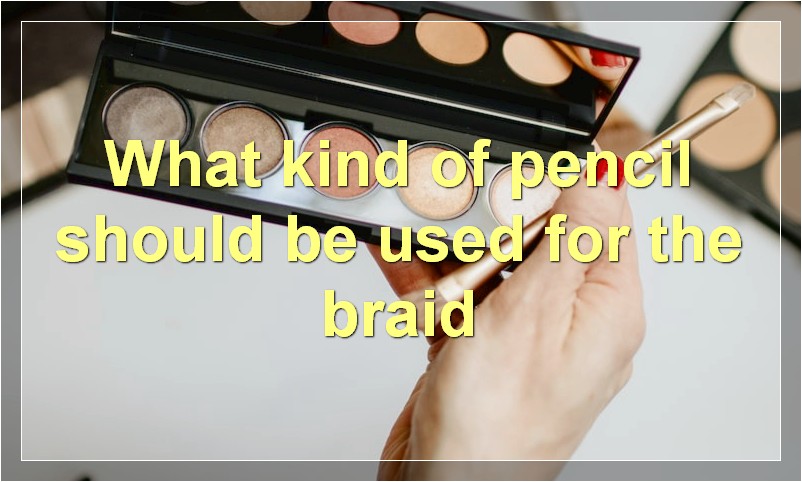If you’re looking for a new hairstyle to try out, why not give braids a shot? They may seem complicated, but with our step-by-step guide, you’ll be able to master the art of braiding in no time!
What are the steps to drawing a braid
When it comes to braids, there are endless possibilities. But how do you actually go about creating one? Here are the steps to drawing a braid:
1. Start by sketching out the basic shape of the braid. This can be done freehand or by using a template.
2. Once you have the basic shape down, start adding in the individual strands.
3. Make sure to cross the strands over each other as you go.
4. To add some realism, vary the thickness of the strands as you go.
5. Finally, add some shadows and highlights to give the braid some depth.
How do you create the appearance of a braid

If you’re looking to add a braid to your hairstyle repertoire, you’re in luck. Braids are versatile and can be used to create a variety of looks, from casual to formal. Plus, they’re relatively easy to do once you get the hang of it. In this article, we’ll show you how to create the appearance of a braid.
Before you start, it’s important to choose the right type of braid for your hair. If you have thin, fine hair, a French braid or fishtail braid is a good option. If you have thick, curly hair, try a Dutch braid or waterfall braid.
Once you’ve selected the type of braid you want to achieve, follow these steps:
1. Start with clean, dry hair. If your hair is wet, it will be more difficult to work with and the braid may not hold as well.
2. If you have time, blow-dry your hair or use a curling iron or flat iron to smooth out any flyaways or kinks. This will make it easier to create a neat and tidy braid.
3. Separate your hair into three sections – one at the top of your head and one on either side of your head. You can use your fingers or a comb to do this.
4. Take the section of hair at the top of your head and divide it into three smaller sections. Begin braiding these sections by crossing the right section over the middle section, then crossing the left section over the middle section. Continue braiding down the length of your hair until all of the hair is braided.
5. To secure the braid, use an elastic band or bobby pins. If you’re using an elastic band, wrap it around the base of the braid close to your scalp and tie it in a knot. If you’re using bobby pins, insert them into the underside of the braid at intervals along its length.
Now that you know how to create the appearance of a braid, experiment with different types of braids and styles to find what works best for you.
What is the best way to start drawing a braid
When it comes to braids, there are endless possibilities. You can go for the classic three-strand braid, or try something more intricate like a fishtail braid or a Dutch braid. But no matter what type of braid you choose, the key to getting it right is starting off with neat, even sections.
If you’re wondering how to start drawing a braid, the best way is to divide your hair into three equal sections. Then, take one section and cross it over the middle section. Next, take the third section and cross it over the new middle section. Continue crossing the sections until you reach the end of your hair.
Once you’ve got the hang of the basic technique, you can start experimenting with different types of braids. If you want something a little more complicated, try adding in some loose strands or doing a four-strand braid. And if you really want to step up your game, try creating an intricate design like a French braid or a waterfall braid.
No matter what type of braid you’re aiming for, the key is to start with even sections and take your time. With a little practice, you’ll be able to create any type of braid you desire.
Where should the braid be drawn on the paper
When it comes to braiding, there are many different techniques that can be used. However, one of the most important aspects of braiding is where the braid should be drawn on the paper.
There are a few factors that need to be considered when deciding where to place the braid on the paper. The first factor is the size of the paper. If the paper is too small, then the braid will likely be too small as well. Conversely, if the paper is too large, then the braid may not fit correctly.
The next factor is the type of paper. For example, if the paper is thin, then the braid should be placed closer to the edge so that it does not rip the paper. On the other hand, if the paper is thick, then the braid can be placed further away from the edge.
The final factor to consider is the design of the braid. If the braid is simple, then it can be placed anywhere on the paper. However, if the braid is more complex, then it should be placed in a specific area so that it does not interfere with other elements on the paper.
How big or small should the braid be
When it comes to braids, the size matters. Smaller braids are often more delicate and can be worn as part of a formal hairstyle. Larger braids are more casual and often considered more playful. So, how big or small should the braid be?
It really depends on the occasion and your personal style. If you’re attending a wedding or another formal event, opt for a smaller braid. If you’re just hanging out with friends or going to the beach, a larger braid is probably more your speed.
Of course, there are no hard and fast rules when it comes to hair. If you think a small braid looks good on you, go for it! The same goes for a large braid. Ultimately, it’s all about what makes you feel confident and comfortable.
What kind of pencil should be used for the braid

There are many factors to consider when choosing a pencil for the braid. The type of paper, the width of the braid, and the artist’s preference all play a role in determining the best pencil for the job.
Graphite pencils are the most popular choice for braiding, as they provide a smooth, consistent line. However, charcoal pencils can also be used to create a darker, more dramatic look. For a wider braid, a thicker pencil such as a carpenter’s pencil or a jumbo pencil is best.
The type of eraser is also important to consider. A kneaded eraser is ideal for correcting mistakes, while a gum eraser is better for lightening lines.
Ultimately, the best pencil for the braid is the one that gives you the desired results. Experiment with different types of pencils until you find the perfect match for your project.
What other materials can be used to draw a braid
When it comes to braids, most people think of using hair to create them. However, there are a variety of other materials that can be used to create beautiful and intricate braids. Here are some of the most popular materials that can be used to create braids:
1. Ribbon: Ribbon is a great material to use for braids because it is soft and easy to work with. You can find ribbon in a variety of colors, widths, and patterns, which gives you a lot of options when it comes to creating your own unique braid.
2. Yarn: Yarn is another popular material for braids because it is also soft and easy to work with. You can find yarn in a variety of colors, thicknesses, and textures, which gives you a lot of options when it comes to creating your own unique braid.
3. Fabric: Fabric is another great material to use for braids because it is strong and durable. You can find fabric in a variety of colors, patterns, and textures, which gives you a lot of options when it comes to creating your own unique braid.
4. Leather: Leather is a great material to use for braids because it is strong and durable. You can find leather in a variety of colors, thicknesses, and textures, which gives you a lot of options when it comes to creating your own unique braid.
5. Beads: Beads are a great material to use for braids because they add a touch of elegance and sophistication. You can find beads in a variety of colors, sizes, and shapes, which gives you a lot of options when it comes to creating your own unique braid.
How can you make the braid look more realistic
When it comes to hair, there are many factors that can affect the way your braid looks. If you want your braid to look more realistic, here are a few tips to keep in mind.
First, pay attention to the way you part your hair. If you part your hair in a straight line, your braid will likely look more like a cornrow. To create a more natural-looking braid, try parting your hair in a zigzag pattern.
Second, choose the right type of hair for your braid. If you have fine, thin hair, using synthetic hair extensions will help add volume and fullness to your braid. On the other hand, if you have thick, coarse hair, human hair extensions may be a better option.
Third, use the right products. When it comes to creating a realistic braid, the right products can make all the difference. Be sure to use a heat protectant before styling your hair with hot tools and use a leave-in conditioner to keep your strands hydrated.
Finally, don’t be afraid to experiment. There are no rules when it comes to braiding, so feel free to try different techniques and styles until you find something that works for you. With a little practice, you’ll be able to create a beautiful, realistic braid in no time!





